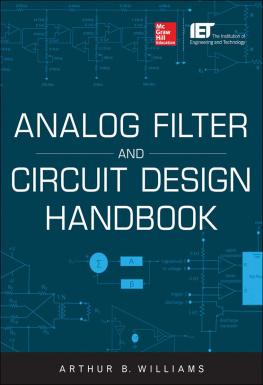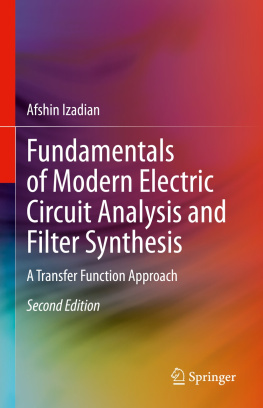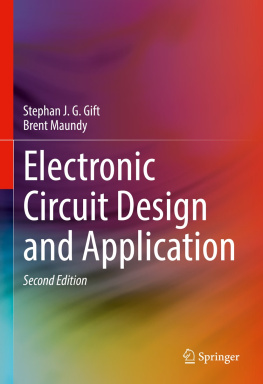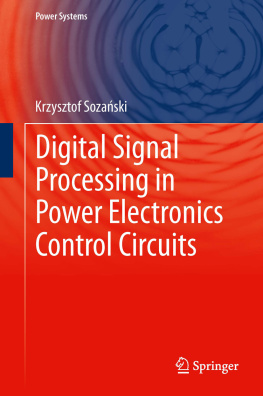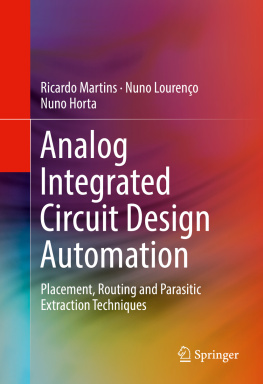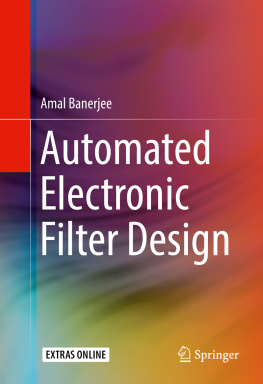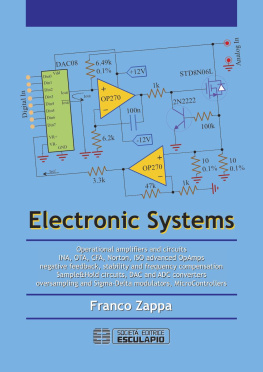About the Author
Arthur B. Williams has over 45 years experience designing filters and analog circuitry. He is the author of 8 books on filters and analog design. He is also the holder of numerous Patents. Mr. Williams has been past chairman of the IEEE Circuits and Systems Society (Long Island) and the recipient of the IEEE Award and Honoree, 2007 For Lifetime Advancement of the Technology of Electronic Filter Design. He is Chief Scientist at Telebyte Inc. where he is involved in the design of test equipment for the telecommunications industry.
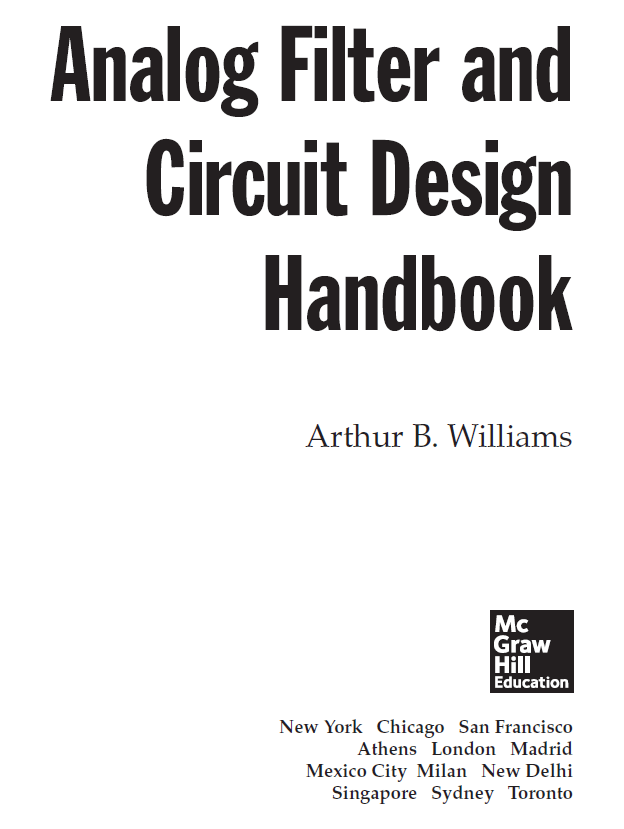
Copyright 2014 by McGraw-Hill Education. All rights reserved. Except as permitted under the United States Copyright Act of 1976, no part of this publication may be reproduced or distributed in any form or by any means, or stored in a data base or retrieval system, without the prior written permission of the publisher.
ISBN: 978-0-07-181672-4
MHID: 0-07-181672-0
The material in this eBook also appears in the print version of this title: ISBN: 978-0-07-181671-7, MHID: 0-07-181671-2.
E-book conversion by codeMantra
Version 1.0
All trademarks are trademarks of their respective owners. Rather than put a trademark symbol after every occurrence of a trademarked name, we use names in an editorial fashion only, and to the benefit of the trademark owner, with no intention of infringement of the trademark. Where such designations appear in this book, they have been printed with initial caps.
McGraw-Hill Education products are available at special quantity discounts to use as premiums and sales promotions or for use in corporate training programs. To contact a representative, please visit the Contact Us pages at www.mhprofessional.com.
Information contained in this work has been obtained by McGraw-Hill Education from sources believed to be reliable. However, neither McGraw-Hill Education nor its authors guarantee the accuracy or completeness of any information published herein, and neither McGraw-Hill Education nor its authors shall be responsible for any errors, omissions, or damages arising out of use of this information. This work is published with the understanding that McGraw-Hill Education and its authors are supplying information but are not attempting to render engineering or other professional services. If such services are required, the assistance of an appropriate professional should be sought.
TERMS OF USE
This is a copyrighted work and McGraw-Hill Education and its licensors reserve all rights in and to the work. Use of this work is subject to these terms. Except as permitted under the Copyright Act of 1976 and the right to store and retrieve one copy of the work, you may not decompile, disassemble, reverse engineer, reproduce, modify, create derivative works based upon, transmit, distribute, disseminate, sell, publish or sublicense the work or any part of it without McGraw-Hill Educations prior consent. You may use the work for your own noncommercial and personal use; any other use of the work is strictly prohibited. Your right to use the work may be terminated if you fail to comply with these terms.
THE WORK IS PROVIDED AS IS. McGRAW-HILL EDUCATION AND ITS LICENSORS MAKE NO GUARANTEES OR WARRANTIES AS TO THE ACCURACY, ADEQUACY OR COMPLETENESS OF OR RESULTS TO BE OBTAINED FROM USING THE WORK, INCLUDING ANY INFORMATION THAT CAN BE ACCESSED THROUGH THE WORK VIA HYPERLINK OR OTHERWISE, AND EXPRESSLY DISCLAIM ANY WARRANTY, EXPRESS OR IMPLIED, INCLUDING BUT NOT LIMITED TO IMPLIED WARRANTIES OF MERCHANTABILITY OR FITNESS FOR A PARTICULAR PURPOSE. McGraw-Hill Education and its licensors do not warrant or guarantee that the functions contained in the work will meet your requirements or that its operation will be uninterrupted or error free. Neither McGraw-Hill Education nor its licensors shall be liable to you or anyone else for any inaccuracy, error or omission, regardless of cause, in the work or for any damages resulting therefrom. McGraw-Hill Education has no responsibility for the content of any information accessed through the work. Under no circumstances shall McGraw-Hill Education and/or its licensors be liable for any indirect, incidental, special, punitive, consequential or similar damages that result from the use of or inability to use the work, even if any of them has been advised of the possibility of such damages. This limitation of liability shall apply to any claim or cause whatsoever whether such claim or cause arises in contract, tort or otherwise.
This book is dedicated to my granddaughters
Leviah and Ilona Ehrlich
Contents
Preface
There have been four editions of the Electronic Filter Design Handbook where each edition had further enhancements over the previous edition. Prior to the books introduction in 1981, the design of passive and active filters was considered a black art reserved for mathematicians and specialists in filter design, mainly because of the tedious calculations required and the skill and experience needed for the proper implementation of the filters. As a result of the book, filters of all types were being designed by individuals with a wide range of technical skills, including hobbyists, technicians, engineers, and scientists. This book became the reference for filters. It appeared on Wikipedia numerous times as the reference for filter-related searches, and was being used as a reference by many technical articles and papers as well as other books.
Although the previous Electronic Filter Design Handbook greatly simplified the design of passive and active filters, a void still existed, as filters are just a specialized segment of general analog design that has always been reserved for specialists. The need existed for a book that demystified analog design in general and expanded beyond filters. That is the function of this book, the first edition of the Analog Filter and Circuit Design Handbook, which not only simplifies filter design, but also breaks down the perception of analog design being a black art. Emphasis has been placed on using operational amplifiers as key building blocks to create working circuits that perform a variety of analog functions.
In addition to developing a strong foundation of understanding how op amps work and their limitations, circuit examples are given. Many of these will perform mathematical functions on analog signals in both a linear and nonlinear manner. Audio applications are shown, such as audio power amplifiers and crossover networks. Both voltage and current feedback amplifiers are covered. Analysis and the impact of nonideal amplifiers are presented. Waveform shaping and generation includes various types of oscillators, both sinusoidal and nonsinusoidal.
The filter-related material presented in the previous book has been revised in the Analog Filter and Circuit Design Handbook, which not only simplifies filter design, but includes new topics and enhances old ones. has been expanded to further emphasize the pole-zero concept and its relationship to a transfer function and to modern network theory utilizing polynomials. The pole-zero concept can provide a useful tool for determining the feasibility of filters, as well as providing guidance as to their optimization. Various methods of synthesis are shown. The trade-offs between active and passive filter implementations are discussed. The frequency limitations of each type are considered.
, including Butterworth, Chebyshev, Bessel, linear phase with equiripple error, transitional, synchronously tuned, and constant delay with Chebyshev stopband. Extensive normalized curves for both frequency and time-domain parameters of these standard polynomial transfer functions are provided. Filter requirement normalization and filter scaling are shown. The highly efficient elliptic-function filter response is introduced in this chapter and emphasized throughout the handbook. Utilization of powerful programs,
Next page
